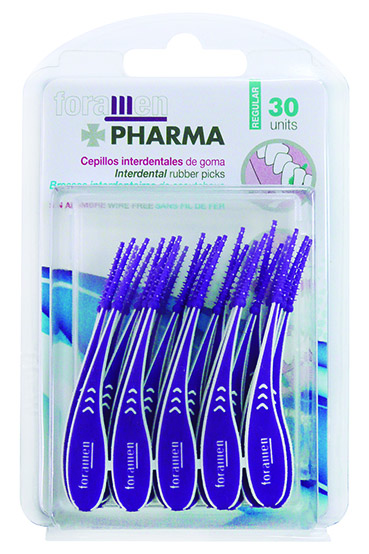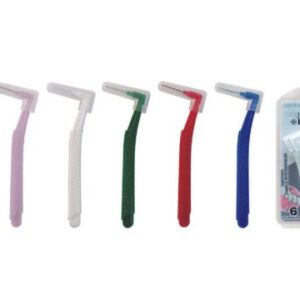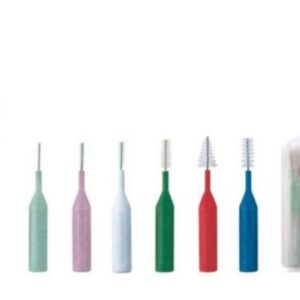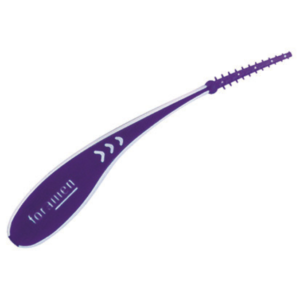
What are Interdental Brushes and what are they for?

When we go to the supermarket or drugstore for a new toothbrush, mouthwash or toothpaste, we see some very strange toothbrushes with a slightly strange structure.
These are interdental brushes, which have a very specific shape that helps them to do their job better, which is quite similar to that of dental floss.
What are interdental brushes?
Interdental brushes are devices designed to address an essential part of oral hygiene: the spaces between the teeth.
Unlike conventional toothbrushes, which focus on tooth surfaces, the toothbrushes we are talking about are specifically designed to penetrate into the recesses of the teeth.
Also known as interproximal brushes, they usually have a thin, elongated design with flexible bristles, which allows them to adapt to different interdental spaces.
Available in a huge variety of sizes and shapes, they are a versatile tool to suit every individual’s needs. In fact, we can buy them in different thicknesses.
That way, even if our teeth are too close together, we will find one with the right thickness and the same happens if the gaps between our teeth are wider.
What are interdental brushes for?
The main function of interdental brushes is more than just tooth cleaning. They play a crucial role in the prevention of oral diseases, such as caries and gum disease.
These spaces between the teeth are prone to accumulate plaque, a sticky film of bacteria that can lead to the formation of cavities and contribute to the development of periodontal problems.
By incorporating interdental brushes into the oral hygiene routine, a more thorough and targeted cleaning is achieved in these hard-to-reach areas.
In addition, regular use can help prevent gum inflammation, reduce the risk of gingivitis and improve the overall health of the mouth.
How are interdental brushes used?
The correct use of interdental brushes is essential to take full advantage of their benefits.
Instead of simply sliding the toothbrush back and forth, it is recommended to insert the toothbrush gently into the interdental space and make gentle back-and-forth movements.
This process helps to remove plaque and food debris effectively without causing damage to the gums or teeth.
It is important to note that interdental brushes should not replace regular brushing with a conventional toothbrush.
Rather, they are used as an adjunct to ensure thorough cleaning and address areas that may be missed with normal brushing.
Are there several types of interdental brushes on the market?
Fortunately, the diversity in the interdental brush market offers options to suit individual preferences and needs. Common varieties include brushes with straight, conical and ball-shaped brush heads.
Interdental brushes with straight head
These brushes are ideal for larger interdental spaces. Its straight design facilitates cleaning in areas where a longer reach is required.
Conical interdental brushes
The conical brushes are versatile and adapt to spaces of various sizes. Its conical shape allows to reach narrower places, providing a thorough cleaning.
Ball-shaped interdental brushes
Designed for hard-to-reach areas, ball brushes are ideal for molars and premolars. Its construction allows for efficient cleaning in intricate sites.
Each type of interdental brush has its own advantages, and choosing the right kind depends on the unique anatomy of each individual’s mouth and personal preferences.
Advantages of incorporating interdental brushes into the oral hygiene routine
Seeing what they are used for and how they work, we can get an idea of the advantages of buying these brushes, especially if we combine them with the mouthwashes that we have developed in Foramen.
With the rinses we will drag the dirt that has been removed by the brushes and we will finish the complete cleaning of our mouth.
Caries Prevention
Thorough cleaning of the interdental spaces helps prevent the formation of cavities by removing food debris and plaque. This will save us more than one visit to the dentist and save money on fillings.
Gum Disease Risk Reduction
By addressing plaque buildup between teeth, interdental brushes contribute to the prevention of gum disease, such as gingivitis, which can be severe and cause teeth to become loose.
Breath Improvement
Because they effectively eliminate bacteria and food residues in the interdental spaces, they contribute to maintain a fresh and healthy breath, which will help to avoid problems in our social relationships.
Share






